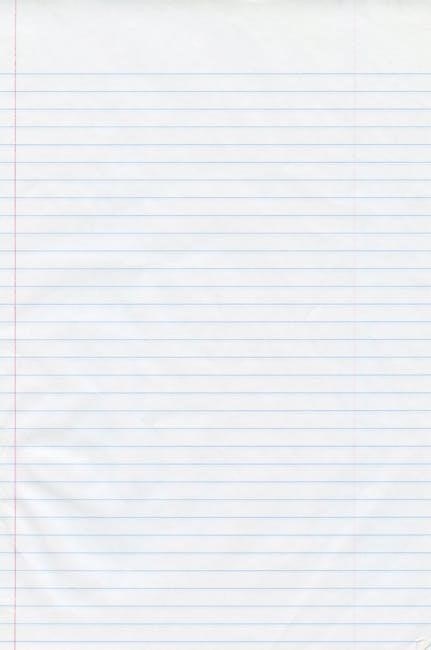A PDF free printable refrigerator temperature log sheet helps maintain accurate records of your fridge’s performance‚ ensuring food safety and compliance with health regulations easily and efficiently.
Overview of Refrigerator Temperature Log Sheets
Refrigerator temperature log sheets are essential tools for maintaining accurate records of your fridge’s performance. These logs help track temperature fluctuations‚ ensuring food safety and appliance efficiency. Available in various formats like PDF‚ Word‚ and Excel‚ they offer flexibility for different users. Whether for home‚ business‚ or medical storage‚ these sheets provide a structured way to monitor temperatures‚ note corrective actions‚ and ensure compliance with safety standards. Many templates are free‚ customizable‚ and easy to download‚ making it simple to start recording temperatures and maintaining proper storage conditions for optimal food preservation and appliance longevity.
Importance of Maintaining Temperature Logs
Maintaining temperature logs is crucial for ensuring food safety‚ preventing spoilage‚ and complying with health regulations. Consistent monitoring helps identify temperature fluctuations that could compromise stored items. By tracking daily temperatures‚ you can address issues promptly‚ reducing the risk of contamination and foodborne illnesses. This practice also supports appliance efficiency‚ extending its lifespan. For businesses‚ accurate logs demonstrate compliance with safety standards‚ avoiding potential legal issues. Regular logging further aids in identifying maintenance needs‚ ensuring optimal storage conditions and protecting valuable contents. This simple yet effective habit is vital for both residential and commercial settings.
Benefits of Using Free Printable Templates
Using free printable refrigerator temperature log templates offers numerous advantages. They are cost-effective‚ saving you money since they are available at no charge. These templates are professionally designed‚ ensuring a clean and organized format that enhances readability. They save time‚ allowing you to start monitoring temperatures immediately without designing a layout. Uniformity is maintained‚ which is crucial in multi-user environments for consistency. Accessibility is high‚ with easy downloads and compatibility with common software. Customization options may be available‚ letting you tailor the template to your needs. Finally‚ they often meet health and safety regulations‚ aiding in compliance without extra effort.

Why Track Refrigerator Temperature?
Tracking refrigerator temperature ensures food safety‚ prevents spoilage‚ and maintains appliance efficiency while meeting health and safety standards consistently. It helps avoid contamination risks and foodborne illnesses effectively.
Food Safety and Spoilage Prevention
Monitoring refrigerator temperature is crucial for preventing bacterial growth and food spoilage. Consistent logging ensures food stays within safe temperature zones (typically below 40°F)‚ reducing the risk of contamination. This practice helps prevent foodborne illnesses caused by unsafe storage conditions. By maintaining accurate records‚ you can quickly identify and address temperature fluctuations‚ ensuring all stored items remain fresh and edible. Regular checks also help extend the shelf life of perishable goods‚ minimizing waste and saving money. A printable log sheet simplifies this process‚ making it easier to track and maintain optimal storage conditions for food safety and quality.
Appliance Longevity and Performance
Maintaining consistent refrigerator temperatures ensures optimal appliance performance and extends its lifespan. Extreme or fluctuating temperatures can strain the unit‚ leading to increased energy consumption and potential breakdowns. Regular logging helps identify patterns or issues‚ enabling timely maintenance and preventing costly repairs. By ensuring your refrigerator operates within its designed temperature range‚ you promote energy efficiency and reduce wear and tear. This proactive approach not only prolongs the appliance’s lifespan but also supports consistent cooling performance‚ safeguarding both your investment and the quality of stored food.
Compliance with Health and Safety Regulations
Using a refrigerator temperature log sheet ensures compliance with health and safety regulations‚ particularly in commercial settings. Many industries‚ such as food service and healthcare‚ are required to maintain temperature records to prevent contamination and ensure product safety. Regular logging demonstrates adherence to standards like HACCP or FDA guidelines‚ helping businesses avoid legal penalties. By consistently monitoring and recording temperatures‚ organizations can prove their commitment to safety during audits. This documentation is crucial for meeting regulatory requirements and maintaining a safe environment for stored products.

Features of a Good Refrigerator Temperature Log Sheet
A good log sheet includes clear columns for date‚ time‚ and temperature readings‚ with space for notes. It should be simple‚ adaptable‚ and easy to print.
Key Columns and Fields
A well-designed log sheet includes essential columns like date‚ time‚ and temperature readings. Additional fields for notes or observations provide context for unusual readings. Some templates offer sections for equipment location or technician initials‚ ensuring accountability. Clearly labeled headers and a clean layout prevent errors. Many free templates also include space for recording corrective actions or maintenance notes‚ making them versatile for different users. These features ensure accurate and consistent tracking of refrigerator temperatures‚ helping maintain food safety and appliance performance. The simplicity of these fields makes the log sheet user-friendly and adaptable to various settings.
Temperature Ranges and Safe Zones
Proper temperature control is critical for food safety; Refrigerators should operate between 32°F (0°C) and 40°F (4°C)‚ with ideal storage at 37°F (3°C). Freezers must maintain 0°F (-18°C) or below. Safe zones ensure food quality and prevent bacterial growth. Temperatures above 40°F risk spoilage and contamination. Log sheets often include these ranges as benchmarks. Regular monitoring ensures compliance with food safety standards. Consistent tracking helps maintain optimal conditions‚ reducing foodborne illness risks. Staying within these zones is essential for preserving food freshness and appliance efficiency‚ making temperature logging a vital routine for households and businesses alike. Accuracy is key to long-term food safety and quality.
Corrective Action Tracking
Corrective action tracking ensures issues identified during temperature monitoring are addressed promptly. This section of the log sheet allows users to document deviations from safe temperature zones and outline steps taken to resolve them. For example‚ if temperatures rise above 40°F‚ actions like adjusting settings or scheduling maintenance can be recorded. This feature helps maintain food safety‚ prevents recurring issues‚ and ensures compliance with health standards. Consistent tracking promotes accountability and improves overall refrigerator performance. It also serves as a record of maintenance activities‚ supporting long-term appliance reliability and food quality. Regular updates ensure problems are resolved efficiently‚ minimizing risks of spoilage or contamination.

How to Choose the Right Template
Select a template that aligns with your specific needs‚ offering essential fields like date‚ time‚ and temperature readings. Ensure it is easy to use and customize.
Consider Your Use Case
Identify the purpose of the log sheet to ensure it meets your needs. For home use‚ a simple layout with basic fields like date‚ time‚ and temperature may suffice. Commercial settings or laboratories might require more detailed templates with additional columns for equipment specifics or multiple refrigeration units. Consider the frequency of temperature checks and whether the template accommodates daily‚ weekly‚ or monthly logging. Ensure the design is user-friendly and adaptable to your environment. Customizable fields can help tailor the sheet to your specific use case‚ making it more practical and effective for consistent monitoring.
- Home use: Simple‚ minimal fields.
- Commercial: Detailed‚ multiple units.
- Laboratories: Precision and specific data.
Formats Available (PDF‚ Word‚ Excel)
Refrigerator temperature log sheets are available in multiple formats to suit different preferences and needs. PDF templates are ideal for easy printing and sharing‚ as they maintain a consistent layout. Word documents offer flexibility‚ allowing users to customize fields and text before printing. Excel spreadsheets are perfect for data analysis‚ enabling users to track trends and set up automatic calculations. Each format ensures convenience‚ whether you prefer a no-frills printout‚ editable fields‚ or advanced data management. Choose the one that aligns with your workflow for seamless temperature monitoring.
- PDF: Fixed layout‚ easy to print/share.
- Word: Editable‚ customizable.
- Excel: Data analysis‚ automatic calculations.
Customization Options
Free printable refrigerator temperature log sheets often come with customization options to meet specific needs. Users can add or remove columns‚ modify headers‚ and include additional notes sections. Some templates allow for the inclusion of company names‚ logos‚ or specific temperature ranges. Customization ensures the log sheet aligns with individual or business requirements‚ making it more practical for daily use. Tailoring the template helps in maintaining consistency and accuracy while monitoring refrigerator temperatures effectively.
- Add/remove columns based on requirements.
- Modify headers for clarity.
- Include company or personal details.

Using the Log Sheet Effectively
Regularly update the log‚ ensure accuracy‚ and review trends to optimize refrigerator performance. Consistency and thoroughness are key to effective temperature monitoring and food safety.
- Use consistently for reliable data.
- Review logs to identify trends.
- Store digitally for easy access.
Step-by-Step Guide to Filling Out the Template
Start by downloading and printing the PDF template. Note the date and time of each temperature reading. Record the refrigerator and freezer temperatures accurately. Check if readings fall within safe zones (typically 32-40°F for refrigerators and 0-5°F for freezers). Document any corrective actions if temperatures are out of range. Include initials or signatures for accountability. Store completed logs in a designated file or binder for future reference. Regular updates ensure compliance and maintain food safety standards. Keep extra copies of the template nearby for convenience.
- Download and print the template.
- Record date‚ time‚ and temperatures.
- Check safe zones and note actions.
- Sign and store completed logs.

How Often to Record Temperatures
Temperature recording frequency depends on the setting and specific needs. For home use‚ daily checks are typically sufficient‚ ensuring temperatures remain between 32-40°F for refrigerators and 0-5°F for freezers. In commercial settings‚ such as restaurants or labs‚ temperatures may need to be recorded multiple times a day to maintain strict safety standards. Consistent logging is crucial‚ with checks ideally performed at the same time daily‚ like morning or closing. This regularity helps in early detection of temperature fluctuations. Always adhere to guidelines from organizations like the FDA for compliance and safety‚ balancing practicality with thoroughness to prevent food spoilage and health risks.
Storing and Organizing Completed Logs
Proper storage and organization of completed temperature logs are essential for maintaining accuracy and accessibility. For physical logs‚ store them in a dry‚ secure location‚ such as a filing cabinet‚ using labeled binders or folders. Digital logs should be saved in designated cloud storage or a password-protected computer folder. Organize logs chronologically or by location for easy retrieval. Regularly back up digital files to prevent data loss. Ensure access is restricted to authorized personnel to maintain confidentiality and compliance. Keeping logs organized helps in audits and quick reference‚ ensuring compliance with health and safety standards while maintaining a clear record of temperature monitoring over time.

Common Mistakes to Avoid
- Inconsistent logging leading to incomplete data.
- Ignoring corrective actions when temperatures are unsafe.
- Not tailoring the template to specific needs.
Inconsistent Logging
Inconsistent logging is a common mistake that can lead to incomplete or unreliable data. Irregular recording of temperatures may result in missed unsafe conditions‚ compromising food safety and regulatory compliance. To avoid this‚ establish a routine for checking and logging temperatures‚ such as daily or multiple times a day‚ depending on usage. Use reminders or designate a responsible person to ensure consistency. Overlooking logging can create gaps in monitoring‚ making it difficult to track trends or identify issues with appliance performance. Regular‚ consistent logging is essential for maintaining accurate records and ensuring the effectiveness of your refrigerator temperature monitoring system.
Ignoring Corrective Actions
Ignoring corrective actions after identifying temperature deviations can lead to serious consequences‚ such as food spoilage‚ appliance damage‚ or even health risks. Corrective measures are essential to address issues promptly‚ ensuring the refrigerator operates within safe temperature ranges. Failing to act may result in recurring problems‚ such as frequent temperature fluctuations or improper cooling. Regularly reviewing logs and implementing corrective actions‚ like adjusting settings or contacting a technician‚ is crucial for maintaining food safety and appliance efficiency. Overlooking these steps can lead to compliance violations and potential contamination risks‚ making consistent follow-through a critical part of temperature monitoring.
Not Tailoring the Template to Your Needs
Using a generic refrigerator temperature log sheet without customization can lead to inefficiency and missed opportunities for precise tracking. Every setting‚ whether residential or commercial‚ has unique needs‚ such as specific temperature ranges or additional notes for maintenance. Failing to tailor the template may result in incomplete data or irrelevant fields‚ making it harder to monitor effectively. Customization allows you to add or remove columns‚ include notes for corrective actions‚ or even adjust the layout for better readability. A one-size-fits-all approach often falls short‚ so adapting the template to your specific requirements ensures accurate and meaningful temperature tracking.

Digital vs. Paper Logs
Digital logs offer enhanced accessibility and automation‚ while paper logs provide simplicity and reliability without technology. Both options ensure accurate temperature tracking for food safety and compliance.
Pros and Cons of Each
Digital logs are eco-friendly‚ easily shareable‚ and automate data tracking‚ reducing errors. They require initial setup but offer long-term efficiency. Paper logs are simple‚ cost-effective‚ and don’t need technology‚ making them accessible. However‚ they take time to fill manually and require physical storage. Digital logs risk data loss if not backed up‚ while paper logs can be lost or damaged. Choose based on your preference for convenience versus reliability. Both ensure temperature monitoring‚ but digital offers scalability and paper provides a straightforward solution. Consider your resources and needs when deciding.
Best Practices for Digital Storage
For secure digital storage‚ use encrypted cloud platforms like Google Drive or Dropbox. Regularly back up files to prevent data loss. Organize logs in clearly labeled folders with dates for easy access. Use strong passwords and ensure only authorized personnel can view or edit files. Consider saving in multiple formats‚ such as PDF and Excel‚ for versatility. Automatically update backups to maintain accuracy. Ensure devices used for storage are virus-free and updated. Schedule periodic reviews of stored logs to verify integrity and accessibility. These practices safeguard your temperature records and streamline future reference or audits. Consistency is key to reliable digital storage.

Free Resources and Downloads
Access free PDF printable refrigerator temperature log sheets from trusted websites like Google Sheets‚ Microsoft Word‚ or Canva. These templates are customizable‚ user-friendly‚ and easily downloadable.
Recommended Websites for Templates
Find reliable PDF free printable refrigerator temperature log sheets on websites like Google Sheets‚ Microsoft Word Templates‚ and Canva. These platforms offer customizable designs‚ ensuring a perfect fit for your needs. Template.net and Vertex42 also provide professional-grade templates for free. Many of these sites allow you to download templates in multiple formats‚ including PDF and Excel‚ making it easy to print or edit digitally. Use these resources to maintain accurate temperature records and ensure food safety. They are user-friendly and designed to simplify your temperature monitoring process effectively.
How to Download and Print
To download a PDF free printable refrigerator temperature log sheet‚ visit websites like Google Sheets or Template.net. Search for “refrigerator temperature log sheet” to find suitable templates. Click the download button to save the PDF to your computer. Open the PDF using a reader like Adobe Acrobat‚ then select the print option from the File menu. Ensure your printer is ready‚ choose portrait orientation‚ and print the desired number of copies. For convenience‚ keep the printed sheet near your refrigerator and use a pen to log temperatures regularly. Consider laminating it for durability.
Consistently monitoring your refrigerator’s temperature ensures food safety and appliance efficiency. Regular logging helps maintain a safe storage environment and prevents potential issues over time.
Final Tips for Effective Temperature Monitoring
To ensure accurate and consistent monitoring‚ check temperatures daily‚ ideally in the morning. Use a reliable thermometer and record readings promptly. Maintain logs digitally for easy access and backups. Notate any corrective actions taken to address temperature fluctuations. Store completed logs securely for future reference or audits. Customize your log sheet to fit specific needs‚ such as noting humidity levels or storage zones. Replace log sheets regularly to avoid overcrowding. By following these tips‚ you can enhance food safety‚ appliance performance‚ and compliance with health standards. Start monitoring today for a safer and more efficient refrigeration system.

Encouragement to Start Using the Log Sheet
Starting to use a PDF free printable refrigerator temperature log sheet is a simple yet impactful step toward improving food safety and appliance efficiency. It requires minimal effort but offers significant benefits‚ such as preventing spoilage and ensuring compliance with health standards. By adopting this habit‚ you’ll gain peace of mind knowing your food is stored safely and your refrigerator is performing optimally. Don’t wait—download a template today and begin monitoring temperatures consistently. This small practice can make a big difference in maintaining a safe and organized refrigeration system. Take the first step now!
